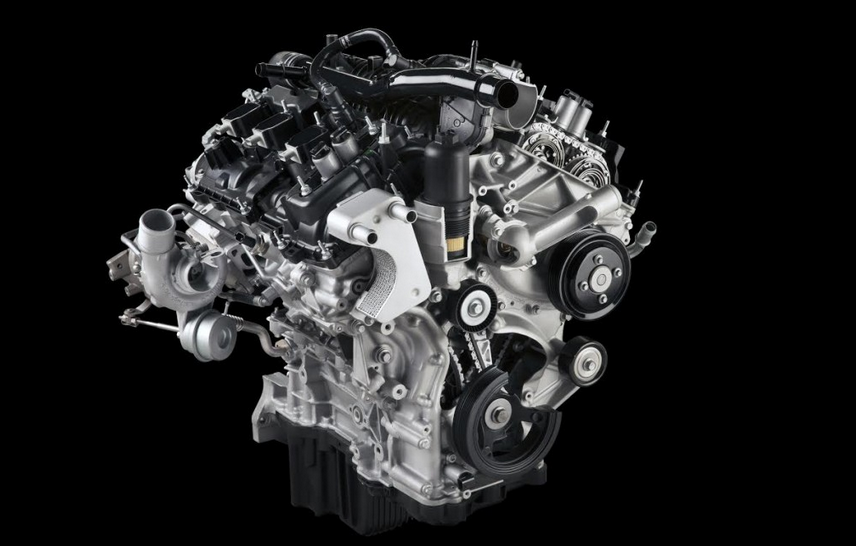
Presented here is an unedited press release issued by Ford today. Images and captions were added by the CG Daily Drive team.
All-New Ford F-150 2.7-Liter EcoBoost V6 Engine Delivers V8 Capability and Performance
DEARBORN, Mich., July 22, 2014 – With its new 2.7-liter EcoBoost® with standard Auto Start-Stop and new 3.5-liter V6 with twin independent variable camshaft timing, the 2015 Ford F-150 resets the bar in light-duty pickup truck performance, capability and efficiency.
“The 2015 F-150 is the most capable F-150 yet, while shedding up to 700 pounds,” said Bob Fascetti, vice president, Powertrain Engineering. “These two new V6 engines – the 2.7-liter turbocharged EcoBoost and normally aspirated 3.5-liter Ti-VCT – set a new standard for Ford for capability and efficiency.”

2.7-liter EcoBoost power
The high-output, twin-turbo 2.7-liter EcoBoost V6 features an entirely new design that delivers power and performance in a strong, smart package. The engine produces 325 horsepower and 375 lb.-ft. of torque – improving the power-to-weight ratio of the 2015 truck by 15 percent over the 2014 5.0-liter V8-equipped F-150 with similar torque output, thanks to vehicle light-weighting.
The 2.7-liter EcoBoost 4×2 has a maximum payload rating of 2,250 pounds and maximum tow rating of 8,500 pounds, ideal for meeting mid-range capability needs.
Boosting 2.7-liter EcoBoost fuel efficiency is the debut of standard Auto Start-Stop technology for F-150. This technology, specially tuned for truck customers, shuts off the engine when the vehicle is at a stop. When the brake is released, the engine restarts quickly. Auto Start-Stop helps reduce fuel consumption and emissions when the truck is stopped and the engine is off. The technology is off when towing or in four-wheel-drive mode.
The 2.7-liter EcoBoost engine also features Ford’s first use of a compacted graphite iron cylinder block in a gasoline engine, the same material used in Ford’s 6.7-liter Power Stroke® turbo diesel V8 in Super Duty trucks. The composite CGI/aluminum cylinder block saves weight while providing strength where it’s needed most for durability.
Advanced technology, power and efficiency combine to create an engine for F-150 that boasts more than twice the horsepower, torque and towing capability of the Toyota Tacoma midsize pickup truck with identical displacement 2.7-liter four-cylinder engine.
Ford testing shows the 2.7-liter EcoBoost also outperforming Ram 1500 3.0-liter V6 EcoDiesel and Chevrolet Silverado 1500 5.3-liter V8 while towing a 7,000-pound enclosed trailer up Davis Dam in Arizona. This is the same grade the Society of Automotive Engineers uses for its J2807 towing testing standards, which the 2015 Ford F-150 will follow.
2015 Ford F-150: America’s Pickup Hits the Gym

3.5-liter V6 tuned for responsive power
Thanks to vehicle weight savings, the standard 3.5-liter V6 with Ti-VCT offers a 5 percent improvement in power-to-weight ratio over the larger 3.7-liter V6 in the 2014 F-150, with better fuel efficiency and performance.
The 3.5-liter V6 produces 283 horsepower and 255 lb.-ft. of torque. The engine has a maximum payload of 1,910 pounds and a maximum tow rating of 7,600 pounds – unsurpassed for standard V6 light-duty pickup trucks.
Designed for impressive power and durability, the 24-valve 3.5-liter V6 features a valvetrain with direct-acting polished mechanical buckets with twin independent variable camshaft timing for impressive torque across a wide rpm range. Six-bolt main bearing caps, a fully counterweighted forged steel crankshaft and cast exhaust manifolds are designed for heavy-duty operation.
Both the upper and lower intake manifolds of the 3.5-liter V6 are tuned for responsive power, and both the intake manifolds and cam covers are composite-formed to reduce weight. The die-cast aluminum cylinder block features bay-to-bay breathing to reduce internal pumping losses, while a deep-sump oil pan contributes to extended oil-change intervals.
How Turbocharging and Supercharging Work: Stuffing a Quart into a Pint Pot
Advanced materials save weight
Extensive research by Ford engineers led to the use of more advanced materials on the 2015 F-150 than found in previous trucks. Military-grade aluminum alloys make the new truck’s body lighter, stronger and more resistant to dents.
Overall, F-150 is up to 700 pounds lighter – helping the truck tow and haul more, accelerate and stop faster, and operate more efficiently than the previous F-150. High-strength steel in the frame and high-strength aluminum alloy throughout the body produce an inherently stiffer truck with greater dent and ding resistance. The aluminum upper body sits on a fully boxed ladder frame with more high-strength steel than ever to make it stronger yet lighter.
In addition to the new V6 engines, the all-new 2015 F-150 offers the proven 3.5-liter EcoBoost and the 5.0-liter V8 with Ti-VCT, providing a comprehensive, capable and efficient engine lineup to meet the specific needs of Ford truck customers.



